We study journalism and the place where the environment and the economy meet in The Jewel.
Don't wanna be here? Send us removal request.
Link
"A scientific report on climate change obtained by The New York Times, part of a regular federal climate assessment, shows that warming is already having a large effect on the United States."
3 notes
·
View notes
Link
“We loved the idea of using biodegradable, especially since we’re a beachfront destination. We never liked using plastic because we usually make the effort to make sure the ocean is not congested with plastic. Hopefully more businesses do the same thing we have started, by switching to bio-degradable straws, containers, and to-go paper bags.” - David Jenkins, Sandbar Restaurant
0 notes
Link
"As a result of the concerns of other landowners and residents, the DOE did visit the site and the bulldozers have gone silent for now."
0 notes
Text
Belize: Government commits to legislating indefinite ban on offshore oil exploration and drilling

PHOTO: OCEANA Belize
Editor’s Note: If the reader ever wonders whether democracy can work in a developing country with many challenges, Belize is an illustration that the answer is “yes.” In 2016, public opinion and outcry literally turned the tide against planned oil exploration in Belizean waters. Now, Prime Minister Dean Barrow has announced his cabinet’s decision to make the resulting moratorium into law. What follows is a press release from the Belize Coalition to Save our National Heritage. - Holly Edgell | [email protected]

Aug. 18, 2017
Right Honorable Prime Minister Dean Barrow officially announced in the House of Representatives today his administration’s commitment and plan to legislate an indefinite moratorium on offshore oil activity in Belize’s territorial sea including its Exclusive Economic Zone. The Belize Coalition to Save Our Natural Heritage welcomes this decision and commends the Prime Minister for his decisive leadership. The Coalition takes this announcement as a commitment by the Government of Belize to fully incorporate the value of our natural resources in developing a sustainable economy.
In his address to the House of Representatives today, PM Barrow stated, “[This is] the consequence of conversation with Oceana and The Belize Coalition to Save Our Natural Heritage, cabinet felt that the time has come to put the policy commitment into writing. It makes no practical difference since under either regime there is not going to be any licenses granted for offshore oil exploration activities. But it certainly, I believe, gives comfort to those who require some comfort that this is a step beyond just the policy commitment”.
In response to a request by the Coalition, the Prime Minister has agreed that a draft bill will be provided to the Coalition in advance to allow time for comment prior to presentation in the House of Representatives in October 2017.
The Prime Minister further committed to ensuring that the moratorium is fully legislated by November of this year. Once enshrined in law, the moratorium would provide the peace of mind that Belizeans deserve on this issue.
Belizeans have been clamoring for the Government of Belize to take legislative action to formally ban offshore oil exploration in Belizean waters since 2011.
Throughout that time, tens of thousands of citizens have remained demonstrably concerned about this issue given the importance of coastal and marine ecosystems to our food, jobs and way of life.
The Belize Coalition to Save Our Natural Heritage reiterates its commitment to the Belizean people that we will remain vigilant and hold the government accountable to its commitment made today. We remain supportive of the Government of Belize’s actions in ensuring that this important legislation is brought to fruition and in ensuring the sustainable management of Belize’s marine resources.
About the Coalition
The Belize Coalition to Save Our Natural Heritage’s mission is to secure a ban on oil exploration in Belize’s offshore and protected areas; and to strengthen the legislative framework for the equitable distribution of oil revenues and promote strong environmental safeguards for the oil industry.
For more information contact:
Janelle Chanona, OCEANA: 610-2358 or [email protected] Nadia Bood, WWF: [email protected]
0 notes
Photo

So this is happening.
0 notes
Link
"...leaders seized the opportunity and decided to take on that challenge—starting with the region’s first national energy action plan developed jointly by the government and investor-owned utility, followed by a pioneering utility solar project that sets this model island nation on a pathway toward a sustainable energy transition."
0 notes
Link
“It is very important for policy makers have a clear understanding of the type and degree of these naturally-based ecosystem services and the benefits they provide to the economy.”
0 notes
Text
That’s a wrap (but the conversation continues)
It was a journey to the intersection of the environment and the economy in Belize: A course for professionals about how to examine the way economic factors impact the nation’s natural treasures.
On Saturday, July 8, 2017, the Belize Coalition to Save Our Natural Heritage concluded the journalism course “Safeguarding the future: the environmental and economic connection in Belize,” with a course completion dinner and award ceremony at the Radisson Fort George Hotel and Marina.

The Coalition partnered with the Department of the Environment, University of Belize, and the U.S. Embassy to bring about the free, 12-month course which included class and field work focused on topics and issues at the heart of Belize’s environmental and economic crossroads.
The curriculum also included modules on basic journalism and newsgathering, skills, best practices, and instruction in the use of social media and digital platforms taught by lead course instructor and facilitator, Holly Edgell, along with guest lecturers.
“We set out on this journey with a simple goal: to put the environment in the headlines. Today more than any other time of our history, we are all too aware that so much of our lives: the air we breathe, the water we drink, is underpinned by our natural assets,” shared Janelle Chanona of Oceana, a founding member of the Coalition.
“As advocates, it’s our duty to call out this reality as catalysts for change. As journalists, your jobs are to broadcast this reality to your audience.” -Janelle Chanona, Oceana
During the course, an enthusiastic group of seasoned Belizean journalists, communications officers, and teachers wrote and uploaded blog posts on various topics to the course blog “Ecopulse Belize,” where details and photos of the class sessions and field trips can be viewed.

Course participants were also required to submit a capstone project at the end of the course which was evaluated by a panel of judges. Courtney Weatherburne of Channel 7 News was awarded for her top score on the capstone project entitled, Environmental Catastrophe, Social Calamity: Monkey River and the Swallowing Sea.
Other Capstone Projects:
Lauren Burn: Belize and ecotourism: Are we loving the environment to death? Ida Ann Collins: Belizean Solar Power Bonanza: Imminent Reality or Pipe Dream? Marleni Cuellar: Act now or forever lose our reef! Duane Moody: One man’s trash is another man’s treasure Dion Vansen: Mangrove reforestation and preservation in Belize coastal areas
“The experience has made me more appreciative and aware of the environment,” shared Weatherburne.
The Belize Coalition wishes to congratulate each participant for their successful completion of the course and looks forward to more stories highlighting how responsible stewardship of the nation’s environment can support sustainable, long-term economic development.

About the Coalition:
The Belize Coalition to Save Our Natural Heritage’s mission is to secure a ban on oil exploration in Belize’s offshore and protected areas; and to strengthen the legislative framework for the equitable distribution of oil revenues and promote strong environmental safeguards for the oil industry.
0 notes
Photo

The Belize reef report scorecard 2017. How are we doing? http://bit.ly/2ugGIwW
0 notes
Link
"Our goal as scientists isn’t to save only endangered invertebrates like coral but to preserve the reefs that hundreds of millions of people depend on." John Bruno
0 notes
Link
"Figures from the World Bank, based on the Sustainable Energy for All (SE4ALL) database, ranked each country by the proportion of renewable energy that made up each country's 'total final energy consumption."
0 notes
Text
Belize and ecotourism: Are we loving the environment to death?
Capstone project by Lauren Burn
Lauren Burn is communications officer at Protected Areas Conservation Trust (PACT) Belize. Here she uses photographs to show the proliferation of tour agencies in the heart of the country.
A major pillar supporting the Belize tourism industry is the environment.
Belize’s ecotourism industry emerged in the 1990s as a sustainable and modern economic formula for progress for which little capital investment was needed and huge returns could be had.
With a growing appetite for unspoiled landscapes from the international community, Belize was poised to become a key player in the industry.
Mass marketing of Belize’s natural environment is creating a negative impact on the very resources it strives to protect.
According to the Belize Tourism Board, the number of overnight tourists to Belize has grown by 41% since 2010.
Ecotourism, in the strictest sense, should be low-impact and full fare; tourism that causes the least amount of damage to the environment, with benefits to local communities.
San Ignacio is often touted as a “green” mecca for tourists. A stroll down Burns Avenue, however, reveals a high number of eco and adventure tour experiences that are superfluous and redundant--with the potential to do more harm than good.
It begs the question, is the marketing of Belize as an ecotourism destination spot sustainable? Or will careless marketing cause us to lose more than we’ve gained?
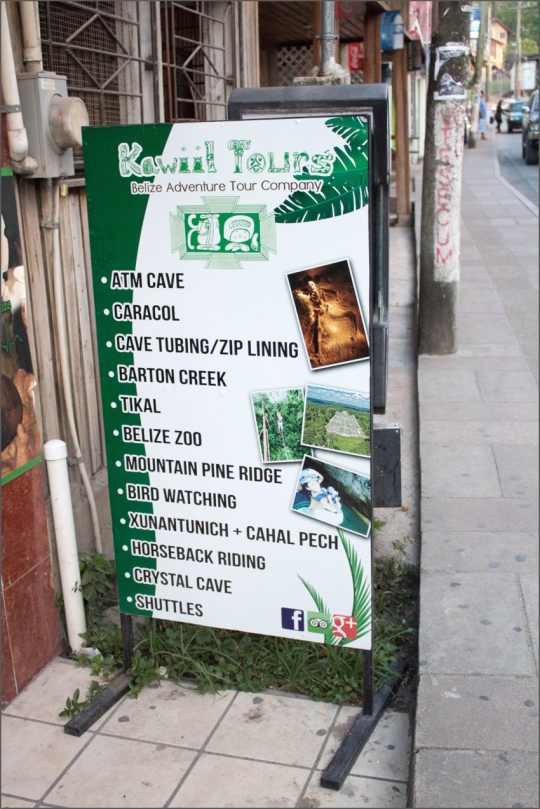
1. Kawiil Tours, specializing in tours to ATM Cave, Caracol, Mountain Pine Ridge and Barton Creek among others.
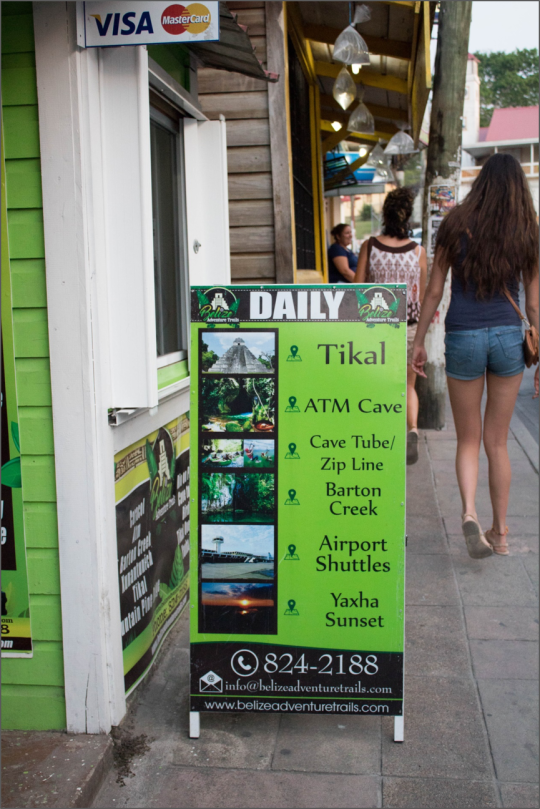
2. Another “adventure trail” company, specializing also in tours to Barton Creek and ATM Cave.
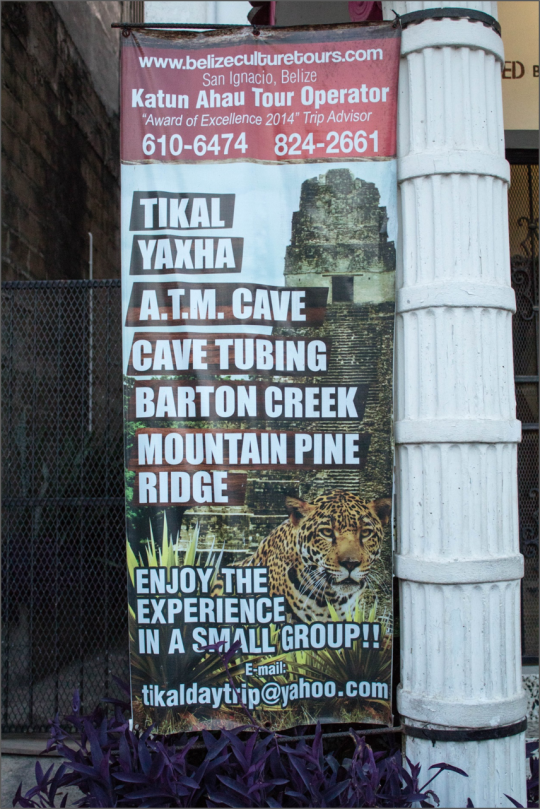
3. Smart. “Enjoy the Experience in a Small Group.” ATM Cave, Barton Creek, and Mountain Pine Ridge re-emerge as top eco destinations.
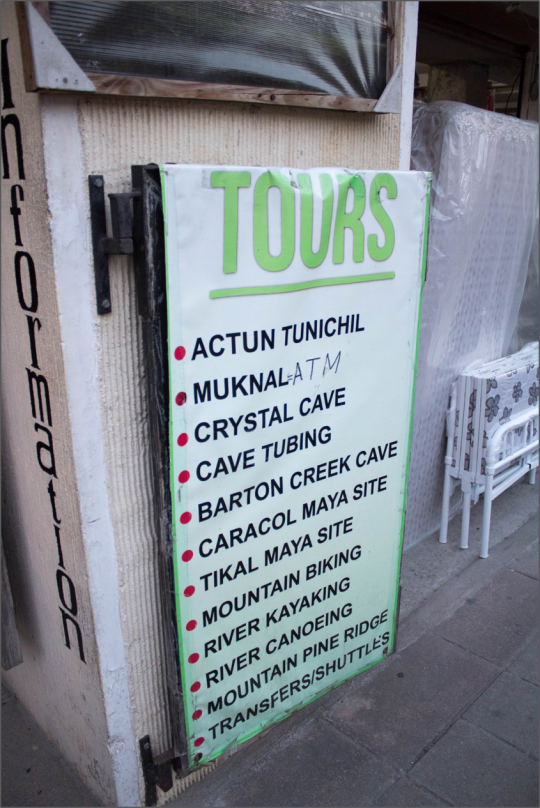
4. Fourth tour company advertisement along Burns Avenue.
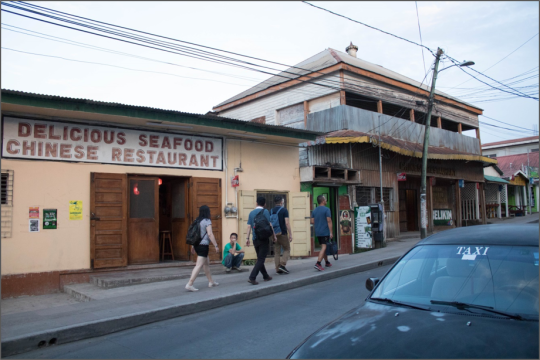
5. Burns Avenue in San Ignacio, Cayo. According to the Belize Tourism Travel & Statistics Digest 2015, the Belize District comes out on top at 23.02% for the percentage of tour guides in the country. Cayo is a close second at 22.72%.
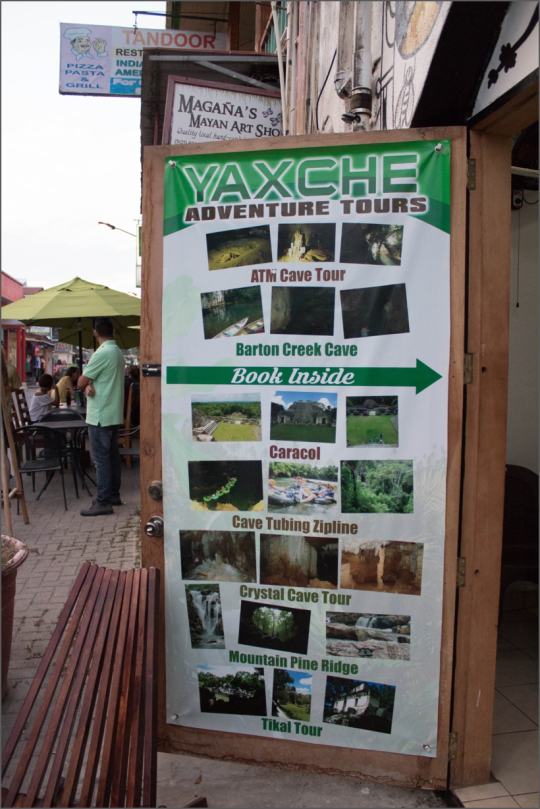
6. "Yaxche" meaning "tree of life" among the Maya: When eco-tourism and cultural heritage marketing collide.

7. The options are endless but the destinations are the same.
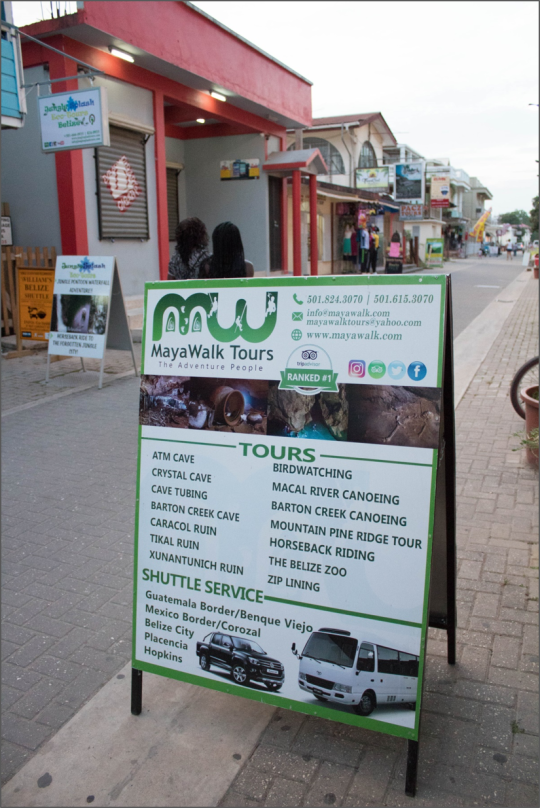
8. Rated number 1 on Trip Advisor.
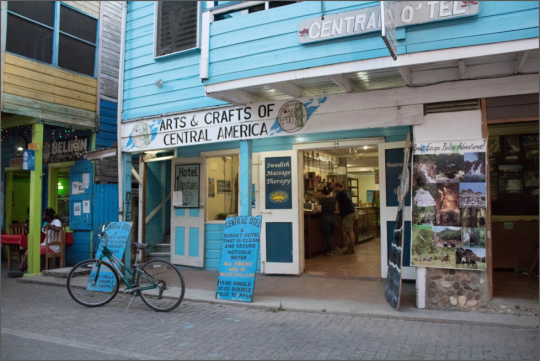
9. Great Escape Belize Adventures. Tourism is steadily shaping our local landscape and industries.
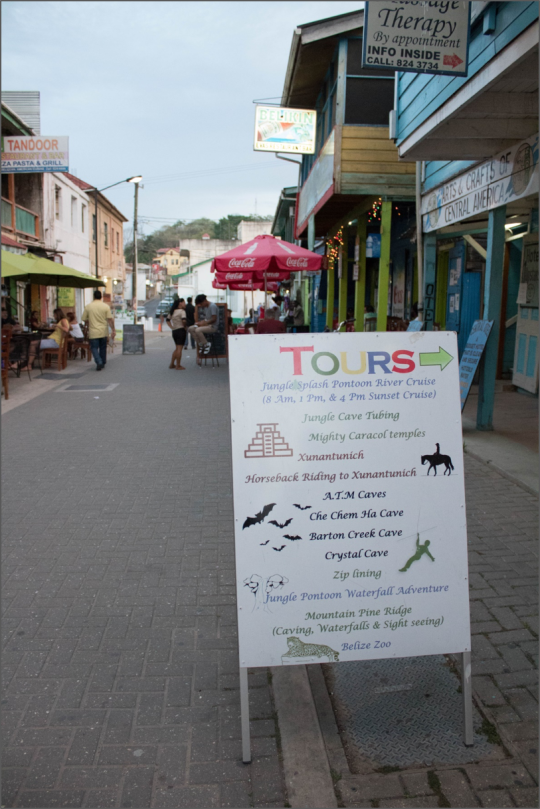
10. Mountain Pine Ridge is a Forest Reserve. Human activity in these and other protected areas is a concern for environmentalists.
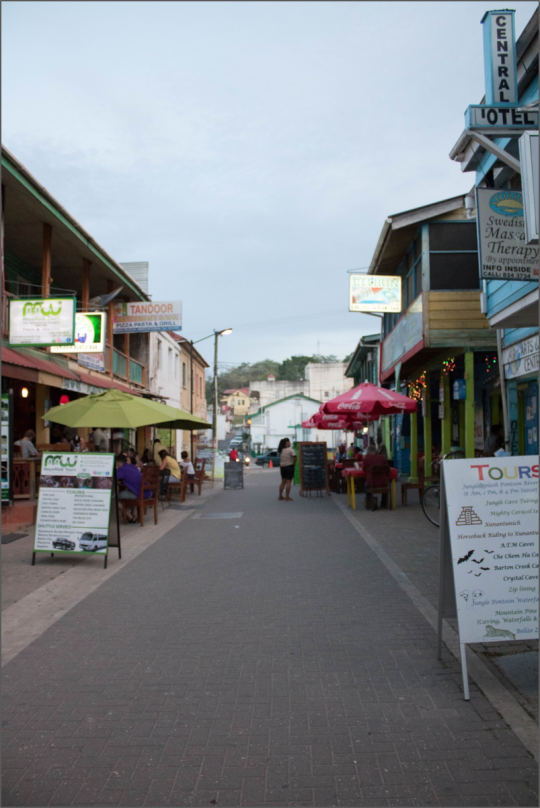
11. The success of the tourism industry is a veritable double-edged sword. While it accounts for somewhere around 25% of Belize’s GDP, small businesses and tour operators often languish during the “slow season” months.
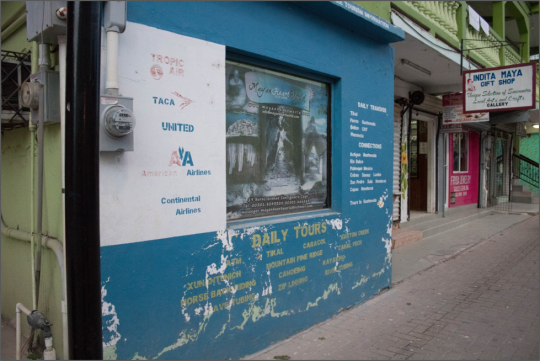
12. Daily tours to Mountain Pine Ridge, Barton Creek and river-tubing among others.
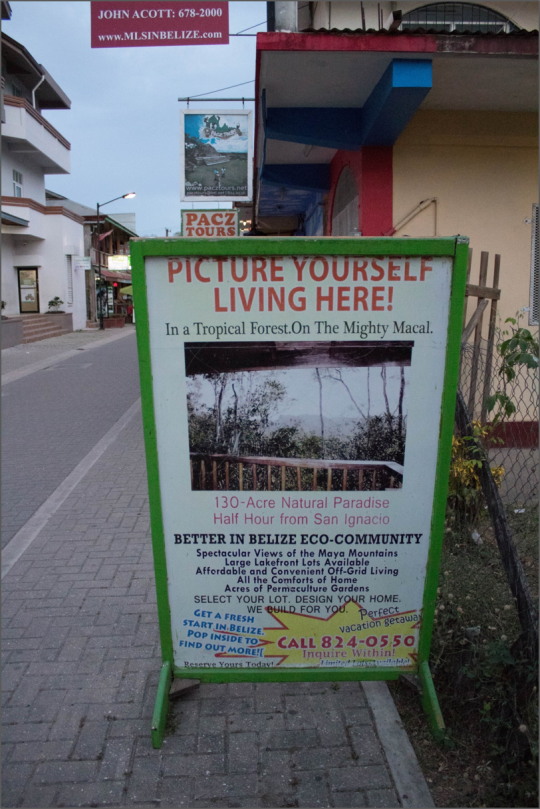
13. "Natural Paradise" just outside of San Ignacio - Better in Belize Eco-Community. Developments like this, by clearing away land, are encroaching on the natural habitat of local wildlife.
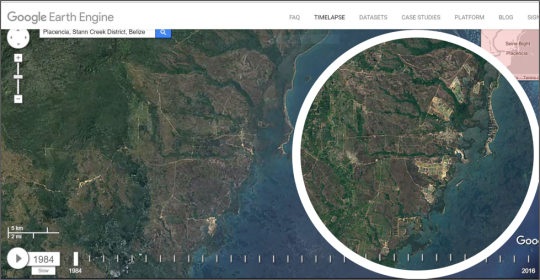
14. Tourism and development are shaping the landscape of Southern Belize - at one time, the least developed portion of Belize. According to the Belize Tourism Board’s Travel and Tourism Statistics Digest 2015, 28.6% of tourists are visiting Placencia, Stann Creek/Dangriga and Punta Gorda.
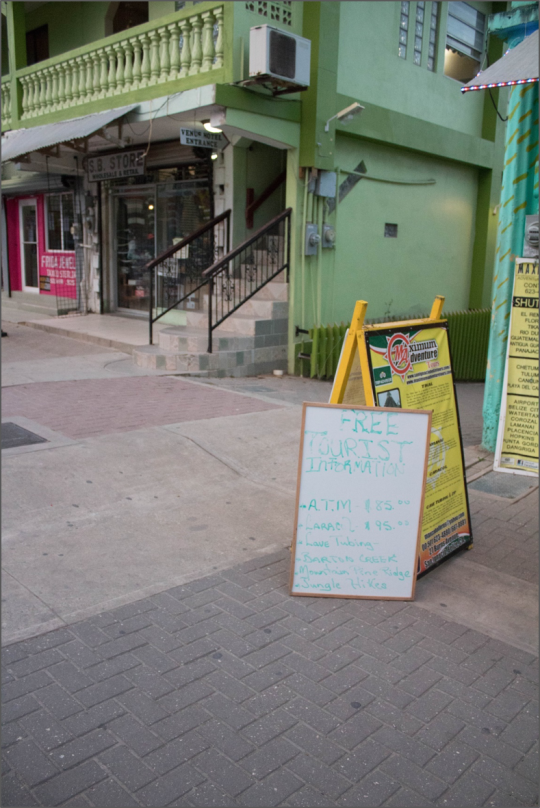
15. Maximum Adventure tours - trips to ATM Cave, Mountain Pine Ridge, jungle hikes and cave tubing among others.
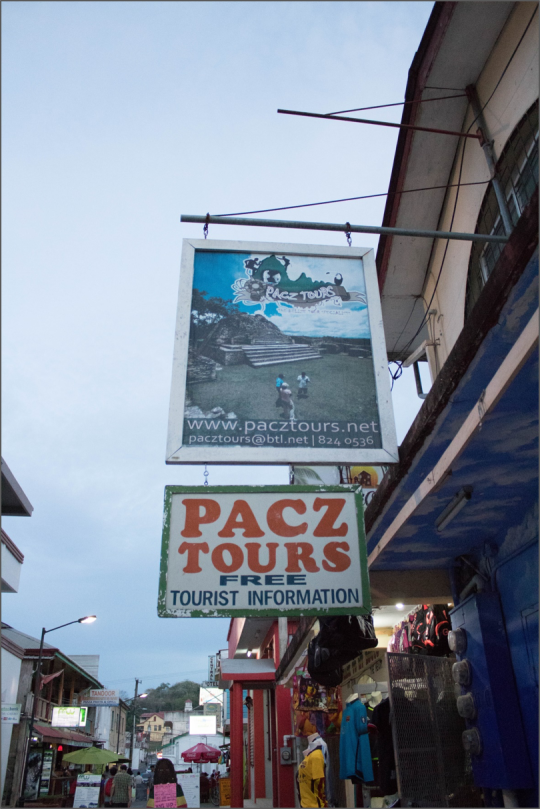
16. With multiple tour companies offering tours of the same sites, how long will the "pristine" remain unspoiled?
What action can people take?
Get involved by supporting authentic eco sites and experiences. Recommend them to friends and family and via social media.
Make stay-cations a thing. Get to know your city, town or village – reduce your carbon footprint.
Volunteer your time at a local school, get parents, children and the community involved by organizing clean-up activities.
Stay informed. Know your rights and legislation regarding your environment. Hold policy makers, government bodies, and statutory instruments accountable for failure to enforce the laws that are meant to guide them.
ABOUT THE CLASS
0 notes
Text
Belizean Solar Power Bonanza: Imminent Reality or Pipe Dream?
Capstone project by Ida Collins
Ida Collins is a retired schoolteacher who is on a mission to fulfill long-held ambition to work as a writer. In this essay, she explores the status quo of solar energy in Belize and provides arguments and ideas for its wider implementation.
Sunshine! Magnificent, intense sunshine!
We enjoy this brilliance in remarkable abundance almost throughout the year.
Recorded averages of direct sunshine hours have been shown to range normally between 5.0 to 9.9 hours. This is without doubt a priceless gift for the taking.
Belize has needs--urgent economic and developmental needs. We also share a global and regional problem: climate change, including global warming.
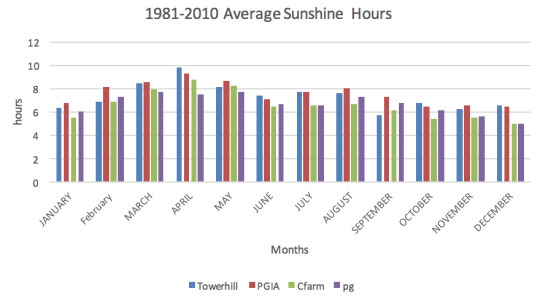
Can Belize use this gift?
Toledo in southern Belize reached out and accepted the gift. An insightful and enterprising Mayan woman, Florentina Choco, traveled to India to learn and master the basics of solar panel technology.
WATCH: Belize's First Indigenous Solar Engineer
She returned home and literally illuminated her village and the lives of her fellow villagers. Through her initiative, the candle and kerosene lamp have become emergency standby. Children study by electric light and link up with the rest of the wider world via television.
It now remains for the application of that expertise to spread further afield, to the crowded urban areas of our country, for instance to Belize City. What would accepting that priceless gift mean in an urban setting?
It would mean a seamstress using her electric sewing machine, not having to cringe on receiving her monthly electricity bill.
A family selling ideals (popsicles) as a sideline would make a few dollars more profit.
Corn tortilla factories could switch to cleaner electrical power and discontinue subjecting their neighborhood to smoke during production hours.
In other words, average people would gain a little more control of their destinies.

“Is it beneficial to all concerned?”
This is a line from the Rotary Club advertising jingle which holds true for the widespread adoption of solar power in tandem with the national power grid.
All concerned would benefit: energy consumers, energy suppliers, distributors and the environment.
I mention the environment last not as an indication of its position on the scale of importance; but simply because often individuals’ perception of their self-interest takes precedence over other equally or more important factors in decision making.
If solar energy is seen to generate good cost savings, it stands a good chance of being adopted on a widespread basis more readily. The environmental benefits would automatically follow.
The amount of fossil fuel needed to run our national power grid would be reduced, thus also reducing the quantity of damaging carbon dioxide emissions produced and released into the atmosphere.
Financial benefits might also be forthcoming, depending on the type and size of solar installation--whether it is a self-contained system or one linked to the power grid.
However, any configuration of solar panels would lessen the total amount of fossil fuel now required, and decrease the load of carbon dioxide released atmospherically, that much less fodder for the alarming waxing greenhouse effect and global warming.
SOLAR PANEL USE IN BELIZE
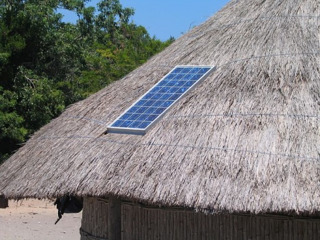
A look at the existing pattern of solar panel usage in Belize shows the following two broad user categories:
Off–the-grid users too far away from the national power grid system to connect to it, often in remote rural locations.
Solar panel users connected to the national power grid who realize energy and cost saving benefits by using both systems to complement each other--given the lack of precise predictability of bright sunny daylight conditions and cloudy overcast or rainy days. Also factoring in are night-time high energy demands.
Off-the-grid users:
Hotels, tourist resorts and some agro-business operations located far from the main grid
Small rural localities in isolated parts of the country. Good examples of these are in the southern district of Toledo mentioned previously, and the Belize River Valley in the Belize District.
A woman from the Belize River Valley came to Belize City on business and proudly described how, with her solar panel system, she now had her own adequate independent power source at an affordable cost.
Another group of small off-grid users is comprised of fishermen on the smaller cayes, who use solar energy to help preserve their catch of fish and conch until they bring them to market.
It is not surprising that groups of small-scale users like these continue to explore and expand their use of solar panel technology to transform their lives and to enjoy additional benefits and conveniences the technology makes possible.
The lifestyle transformation that occurs when electrical power is brought to areas that were previously without it can be dramatic. It affords time-saving through the use of labor saving power tools and electrical appliances that allow people time for other beneficial pursuits. Additional income generating activities are spawned or expanded. For instance, wood carvers and craftsmen revel in their new found ability to increase their output several times over and increase their income.
This circumstance probably does not often come up for mention, but the fire hearth, which produces some of the tastiest of dishes, relies on a wood fire. It can be a very smoky affair at times which many rural women are glad not to have to deal with on a daily basis any longer. It can be a threat to both health and the environment.
On-the-grid users
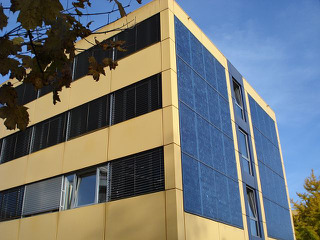
Quite a number of major consumers of electricity such as big businesses, government institutions and luxury home owners have installed solar panel systems while remaining linked to the power grid.
Their aim is to reduce the cost they pay for electricity. Since they have access either to loan capital or expendable funds they can afford the installation and maintenance costs of the solar power systems that meet their power consumption requirements.
Often, in the case of hotels, energy saving lighting and hot water systems are main areas of cost saving. Retaining both operating systems, the national electricity grid and their solar systems and using them strategically, yields worthwhile cost savings.
While the sun shines and their solar system storage capacity is not exhausted, solar power is brought into service. Conversely, when there is no sunshine and the storage batteries for the solar system are depleted the national grid meets the power demands. This is undoubtedly a win-win situation once the initial installation costs have been cleared.
ELECTRICITY IN BELIZE
The country’s sole electricity provider, Belize Electricity Limited (BEL), declares itself ready to move with the times.
It prides itself on providing electricity in a reasonably efficient way and at a comparatively manageable cost. Many residents of Caribbean islands pay higher electric rates than Belizeans.
The scattered small villages countrywide are gradually being added to the power grid, but not quickly enough for the villagers. Hydro-electricity from the Chalillo and its companion dam supply a portion of BEL’s electricity.
Imported fossil fuel still looms large in the energy supply configuration, together with electricity purchased from neighboring Mexico at fairly favorable prices depending on surplus availability.
BEL, aware that some of our Caribbean neighbors have ventured boldly into the use of solar energy, publicized its commitment to expand the use of more green and environmentally friendly energy sources. It invited tenders for solar and other forms of cleaner energy. A submission for a solar project to supply 10% of the country’s current peak demands was received.
An extremely informative interview with a BEL staff engineer was characterized by a keen awareness of the inevitability of BEL shifting further toward utilizing green energy in fulfilling its function of energy transmission and distribution.
He highlighted and clarified some of the technical, legal and organizational issues that would need to be addressed. These included the following:
The legal preliminaries needed to govern the new provider-consumer relationship to be worked out with the Public Utilities Commission (PUC). This body regulates and controls the functioning of the utility companies, including rates charged for services.
A metering mechanism to regulate the process of accepting customers’ surplus solar energy into the grid in the interest of efficiency and grid stability.
In fact, some customers with medium to large solar installations already have been pressing for an arrangement to sell their surplus power to the grid.
These preparatory provisions take time and cost money, but it would happen in due course. The BEL engineer concluded with the bit of good news that the cost of solar technology systems continued to drop.
Planners and policy makers in the Caribbean are on the alert for sub-standard equipment from abroad and are looking into the possibility of manufacturing their own jointly in the region.
FINANCING SOLAR ENERGY
The average citizen with limited financial resources seems to have extremely limited access to loan funds for solar technology acquisition.
In Belize the Development Finance Corporation (DFC) offers “Renewable Energy and Energy Efficiency Financing” This, however, is specifically for businesses.
The loan brochure lists DFC’s target sectors: Tourism, Agriculture, Manufacturing, Agro-processing, Business services and Residential (apartments).
Average home owners do not qualify for this 6% p.a. interest rate payable on the reducing balance.
Large-scale project funds from other sources do of course exist. A large-scale solar energy project for a salt water reverse osmosis desalinization plant at Caye Caulker, one of our well populated cayes, clearly demonstrates the environmental benefits of solar power.
This US $200,000 project, a 70kwh three phased photo-voltaic solar system connected directly to the grid, was implemented by the Caribbean Community Climate Change Centre with the cooperation of Belize Water Services Ltd., BEL and relevant government ministries. It avoids 95 – 100 tonnes of carbon dioxide from being released into the atmosphere.
The proposed Belize City initiative could conceivably begin with as little as a single panel or two per house, with expansion graduated over time as cost savings permitted if government savings were unavailable. This is where the Toledo experience would prove invaluable.
CONCLUSIONS
The cost quotes from our local solar panel suppliers put the minimum price tag of the smallest available solar panel system at $3,000 in Belizean currency-- equivalent to US $1,500--well above the comfort level of affordability for the majority of average Belizeans.
It therefore seems that a special small project can be drawn up for a limited area. This could be implemented as a pilot project with the collaboration of certain institutions with interest and expertise of this sort, starting with our Institute for Technical and Vocational Training (ITVET).
The Orange Walk branch of the ITVET might be particularly interested in such an experiential opportunity for their budding technicians and their instructors. The University of Belize (UB) should not be bypassed in this exciting experiment either. heir Engineering Department could play a valuable and key role in this project.
If a sweat-equity element were built into the project, and also a small percentage of cost as a homeowner’s contribution, perhaps arranged through our credit unions, this would add a desirable element of self-help and entrepreneurship to the project.
The proposal could be submitted to some of the many development agencies that champion human resource enhancement.
The project’s success would then justify its replication. Would this be “beneficial to all concerned?” It would be worth finding out.
ACKNOWLEGEMENTS
Belize Weather Bureau – Ms. Catherine Cumberbatch (Chief Meteorologist)
Regional Climate Change Centre (Belmopan) – Mrs. Ann Gordon
Belize Electricity Limited - Mr. Herschel Armstrong (Engineer)
Development Finance Corporation (Loans)
Pro Solar Engineering Ltd.
Karl H. Menzies Ltd - Ms. Kay Menzies
Love FM Radio & TV - Mrs. Ava Diaz ( Santa Teresa, Toledo solar project interview )
Photo of the Sunrise & Graph of Hours of Direct Sunshine are courtesy of Belize Weather Bureau.
ABOUT THE CLASS
0 notes
Text
Act now or forever lose our reef!
Capstone Project by Marleni Cuellar, May 2017
Marleni Cuellar is a news anchor and reporter with News 5 Live in Belize. In this photo essay, she takes on the role of an advocate for the Belize Barrier Reef system, curating images and information that covers threats to the system as well as efforts to keep these threats at bay.
While Belize has never held the distinction of hosting THE GREAT Barrier Reef, you certainly cannot tell any Belizean that our Barrier Reef is not THE GREATEST.

Jump out of a plane? Why not, with this view off the coast of Ambergris Caye. It is perhaps the second best way to view the magnificent Barrier Reef. (Photo: Marleni Cuellar)

The view from above has to come second when an underwater perspective offers an up-close encounter with colorful fish like these. (Photo: Henry Brown)

(Photo: Henry Brown)

(Photo: Henry Brown)
The Belize Barrier Reef System lies about 300 yards off the shore of the mainland. It spans the entire length of the country: about 180 miles long.
This outstanding ecosystem was formed over hundreds of years and is the longest living reef in the world.
It’s a natural haven for marine life including threatened species.
In 1996, it earned the distinction as a World Heritage Site by the United Nations Educational, Scientific and Cultural Organization (UNESCO).

(Photo: Henry Brown)

(Photo: Henry Brown)
But this distinction is at risk. Since 2009, the Belize Barrier Reef System is listed as a World Heritage Site in Danger. Knowing all the benefits that the reef provides us, we should all be very concerned.

Tourists on Silk Caye
The Benefits of the Belize Barrier Reef
Tourism
Tourists from all over the world travel to Belize for our many attractions. In 2016 alone, there were over a million cruise ship passengers and the overnight tourist count increased by nineteen thousand visitors.
The industry been steadily growing, attracting more and more cruise as well as overnight tourists each passing year.
One of the biggest attractions for people who visit the country is, of course, the reef. Eco-tours--specifically snorkeling and diving--are two of the top activities that tourists seek when traveling to Belize.

Sharing this submerged gem is crucial to our economy, as tourism is the top income generator for the country and also the top foreign exchange earner.
The tourism industry contributes a whopping 29% of the country’s Gross Domestic Product (G.D.P.).


Marine Life
The Barrier Reef creates a protective haven for over 500 species of fish, and is home to a number of threatened marine species.
Belize proudly boasts the largest population of West Indian Manatees: a population of just about a thousand.
When it comes to seafood, there is a lucrative export market for lobster and other fisheries products which are important to our economy.
Did you know that Belize actually exports lobster that you may consume at the very popular Red Lobster?

Protection
By its name alone, we are reminded of one of the lesser recognized blessings of our reef: That it serves as a protective barrier.
The Belize Barrier Reef is located offshore and, along with the mangrove cayes, it protects our shorelines, our infrastructure and people from erosion and from even more devastating effects of tropical storms and hurricanes.
RELATED: Mangrove reforestation and preservation in Belize coastal areas
Visiting surfers may not be so happy, but I'd say it’s fair trade off. Our coast is not completely spared of erosion as these pics of Monkey River and other southern coastline communities still battle to minimize erosion.

The Belize Barrier Reef is inextricably linked to Belizeans’ perception of heritage and culture. Even in our multicultural society, we all share a great pride in the ecosystem, showcasing its rich beauty in just about any way we can. It’s not uncommon for carnival costumes and event pageant costumes to depict the beauty of the reef.

(Photo: A Appolonio)
Now, one would think that with all the blessings that the Barrier Reef provides, we would do all we can to protect it. Sadly, that is not the case. Threats to this delicate ecosystem are real and persistent.
Threats to the reef

Offshore Oil Drilling
Why? Unfortunately, the answer is very simple: money. While at this point, there is an ongoing campaign to persuade the Belizean government to ban offshore oil exploration, it still remains one of the major threats to this magnificent reef system.
The “Say NO to Offshore Oil Drilling Campaign” was initiated in 2012 after it was revealed that there were concessions (contracts) blocking off the entire reef for possible oil exploration.
There have been some gains in the battle because the message is unchanged. Belizeans do not want to sacrifice our reef for short term gains from an oil discovery.

In 2012, as a part of the “Say NO to Offshore Drilling Campaign,” environmentalists created the map above to show what a spill the size of the Deep Water Horizon oil spill in the Gulf of Mexico would look like over Belize.
Illegal Fishing
As a nation, we are not entirely blameless when it comes to the threats to our reef. Specific marine resources in Belize are regulated. Despite continuous education on seasonal fishing and size requirements, there will still be those who completely ignore the rules.

This (above) is the seizure of undersized conch and out-of-season lobster. The fishermen – who were not first time offenders – were ordered by the court to pay a fine or face jail time.
Climate Change

Like a whitewash over once vibrant pink purple and blue coral; bleaching is caused by rising sea temperatures and has been a problem affecting the reef for some time.
While it is not a problem exclusive to Belize, the effects of climate change, such as rising sea levels and warmer waters, do adversely affect the health of the coral systems in the reef.
Coral bleaching has been well documented across the expanse of the reef and continues to warn us that climate change is real.
Manmade Damage

The environmental community in Belize has long called for a sustainable approach to development within protected areas. Whereas there has been a moderate attempt to protect the riches we hold in natural resources, it doesn’t necessarily limit the requests from investors to maximize the beauty of Belize with developments that either out-rightly jeopardize the reef system of indirectly cause harm to the reef.
Gladly, a project to build a private airstrip on a reef system has suffered a natural death, but the reef is still severely affected by waste water from agricultural developments and irresponsible seamen.
So what have we been doing about it?
Advocacy

Over the years, environmentalists have been able to garner much support from individual interest groups and the wider public to join in their different causes.
In November 2016, environmental organizations along with the tourism sector successfully advocated for the halt of an already scheduled offshore seismic survey by TGS in Belizean waters.
Advocacy, coupled with grassroots community educational outreach and a sustained media sensitization campaign, has been effective in keeping all Belizeans in the loop.
Innovative plans and partnerships

Belize has established environmental agencies and policies to better manage the protection of our natural resources, especially the barrier reef.
Co-management agreements as well as non-governmental and government agencies collectively work to protect this magnificent resource.
In February 2016, Belize adopted the Innovative Integrated Coastal Zone Management Plan. But, as reported by Channel 5, Belize Audubon Society’s Amanda Burgos stated, “we have mentioned the Integrated Coastal Zone management Plan and the fact that that policy is now Cabinet endorsed, but it’s difficult to enforce it, so it needs some kind of legal teeth. So the work continues.”

When it comes to over-fishing resources, no one knows better about the effects than the traditional fishers. That's why, when attempting to get fishers on board with sustainable fishing practices, they were the most obvious and willing partners.
The managed access program helps fishers not only practice sustainable fishing, but also oversee themselves to ensure that the right fishing practices are being utilized in their specific communities.
Reef Report Card
Another great initiative that has become an essential tool in monitoring progress of the protection and preservation of the reef is the Reef Report Card conducted by the Healthy Reef for Healthy People Initiative.
It allows for an in-depth analysis of the progress and challenges found within the reef system produced two years.
The data is not only collected but shared with the public so we can all know how effective we are in maintaining this resource.

The 2015 Reef Report Card highlighted Belize’s effectiveness in research and policy, but indicated that there needs to be better management of agricultural runoff, wastewater and pollution.
You can find the past three report cards here.
What can we do? (If you read nothing else on this photo essay, read this)!

Keep up the pressure
In 2012, Belizeans proved they could show up and speak up when over thirty thousand registered voters participated in the People’s Referendum. An overwhelming number, 96% of participants, voted against offshore oil exploration.
Even with the resounding “NO” to offshore drilling, the Belize Coalition to Save our Natural Heritage is still advocating for a total ban on offshore exploration.
This is why Belizeans must stay involved and up to date with the decisions of leaders and ensure that we keep up the pressure.
Volunteering with environmental groups can go a long way. You can even start your own community environmental group to keep education and advocacy efforts on the front burner.
Share in the experience

Half Moon Caye
It’s unbelievable that so many Belizeans who hold so much pride for our reef system have never even been close to it.
If you can make it out to Caye Caulker or one of the closer cayes, go the added distance and book a snorkeling tour at the reef. This year alone, there are eight trips being organized through a group of environmental agencies to encourage Belizeans to Explore Belize’s World Heritage Sites.
Here’s a list of on Facebook with the dates. Find the time and GO!
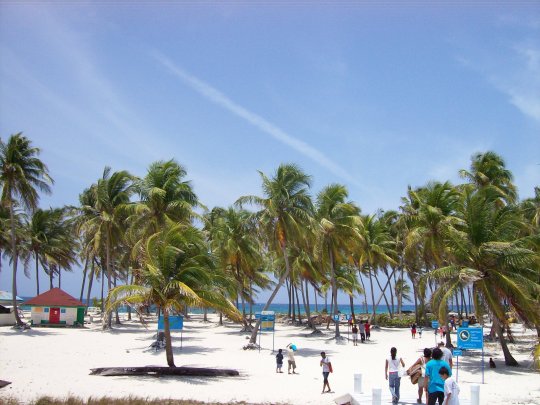
Last year I took my mother on a Belize Audubon Society Trip to Half Moon Caye and the Blue Hole: in her early 70s it was her first time there!
When you’ve seen the true beauty that we possess in our own country, will you be driven to share in its protection? The threats are real, and we all need a firsthand experience of what’s really at stake.
Curb those bad behaviors and develop even better ones.
Yes, we’d all love to enjoy our favorite seafood whenever we like. I mean, it could be considered a God-given right as natives of the tropics; but, closed seasons serve a purpose.
These regulations, are put in place to ensure that we can have grouper, lobster and our beloved conch in the future. Otherwise, we risk wiping out entire species of foods we love.
So, do not fish out of season and do not purchase or consume undersized catch when you know the season is closed.
Know the seasons and do your part!
Conch Season closes July 1st to September 30th
Lobster Season closes February 15th to June 14th
Nassau Grouper closes December 1st to March 31st
Ambergriscaye.com has a full list of seasons & fisheries regulations; here’s a helpful poster.

Lionfish (Photo: Sean Kuylen)

Cooking lionfish (Photo: Sean Kuylen)
You can also develop a new favorite seafood for the off-season, like lionfish! This invasive species is the real enemy of the reef and one that has been hard to contain.
The only way to beat it is to eat it! Maybe you can even be lucky enough to have Belize’s top chef Sean Kuylen prepare it in a meal.
Legalize it!

This one may seem a little far-fetched: Did you know that in March of this year New Zealand granted a river the legal rights of a human?
It took the Maori Tribe over 100 years of legal battles to achieve this great victory.
For the rest of the world; it means the possibility exists to allow for the legal protection of a natural resource as we would a fellow citizen; just the way we are protected from any type of harm, this river system is as well.
Gerrard Albert, lead negotiator for the Whanganui (also the name of the river) tribe, is quoted by The Guardian as saying after the historic victory:
“Rather than us being the masters of the natural world, we are part of it. We want to live like that is our starting point. And that is not anti-development, or anti-economic use of the river but to begin with the view that it is a living being, and then consider its future from that central belief.”
Truth be told, having read about the Whanganui in New Zealand prompted the concept of this photo essay. Why not? Because beyond the dollar value of the Belize Barrier Reef, this system is a part of our identity as Belizeans and should have the fullest protection of the laws in the country and if that means that it’s give the equal rights to protection as me as a human: Well, I'm good with that!
ABOUT THE CLASS
#reef#Barrier Reef#belize barrier reef#coast#coastline#Belize#oil exploration#oil drilling#tourism#fishing#fisheries
0 notes
Text
One man’s trash is another man’s treasure
Capstone project by Duane Moody
Duane Moody is a news reporter with News 5 Live in Belize. He uses video to show how Belize’s perennial battle with garbage is being fought with improved planning and economic incentives.
For years, fires broke out at the former dump site at Mile 3 1/2 on the George Price Highway. The pungent stench affected residents in the immediate area, and the unsightly mountains of garbage were an eyesore at the eastern entrance of Belize City.
But an initiative by the Government of Belize has transformed garbage into money. This story looks at how recyclers, also known as balers, extract materials with financial prospective from solid waste. One man’s trash can literally be another man’s treasure.

As part of Belize’s national solid waste management plan and the success over the last five years, the project is being replicated in the northern and southern corridors of Belize.
Sanitation is an expensive venture for any municipality; in Belize City alone it adds up to forty percent of the local government revenues.
vimeo
MORE:
Details on municipal sanitation
The Belize Solid Waste Management Authority
Learn about the loan facility to construct and ensure environmentally sound waste management.
ABOUT THE CLASS
0 notes
Text
Mangrove reforestation and preservation in Belize coastal areas
Capstone project by Dion Vansen, May 2017
Dion Vansen is a reporter for the San Pedro Sun. In this article and photo essay he shows the impact of removing mangrove and the creative efforts underway to reforest Belize’s mangrove systems.
Mangroves are a unique plant species which grow in salt water. Belize is considered to have the highest overall percentage of mangrove cover of any of the Central American countries.
In past years Ambergris Caye and most of the coastal area of Belize were packed with this important plant species; however, it is now being threatened by clearance for development.
On the island and other parts of the country, the trend of mangrove deforestation is increasing dramatically, and as a result erosion has been eating away the beaches.
In an effort to save the coastal line and the mangrove population, a reforestation project has been taking place for the past years with some successful outcomes; however more needs to be done.
Marine Biologist Valentine Rosado, is a passionate advocate in the reforestation of the mangroves. One the biggest projects held in 2010 saw the survival of a few mangroves.
“We visited the site in 2017, and noticed that the mangroves were affected by global warming, tourism development,” he said.
He stated that disturbances will continue coming their way; thus, there is a need to replenish mangroves each year, so there is a multi-age mangroves that would make the site more resilient.
MAP: Click here to interact with the map
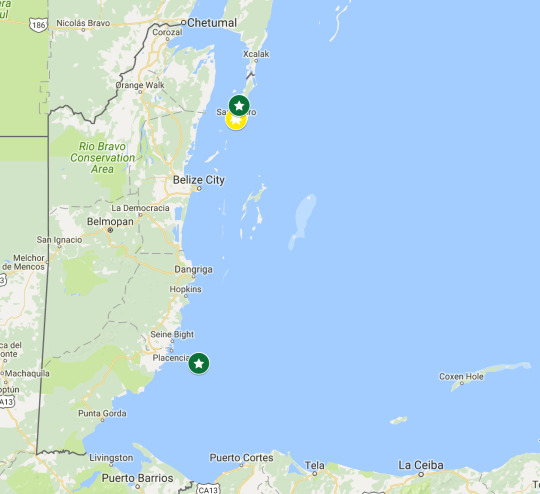
The mangrove reforestation has spread as far as Laughing Bird Caye, where the Riley Encased Methodology (REM) provides sustainable development technology with the potential to build coastal resilience and promote biodiversity.
Scroll down to see a photo essay of REM in action
As in San Pedro, Ambergris Caye, this achievement will be possible through the establishment of functional mangrove habitats in high-energy environments.
The establishment of REM in San Pedro has facilitated the adaptation of mangroves with an acceptable amount of survival over a period of three years.
Even though the biggest threat for mangrove population is infrastructural development, other methods exercise to create awareness for their preservation are sporting events such as kayak races, which take participants through rich areas of mangroves in order for them to appreciate its great significance.
For more information on mangrove reforestation visit www.grassrootsbelize.com or contact Valentine Rosado at [email protected]
Also check related articles in The San Pedro Sun Newspaper: www.sanpedrosun.com
PHOTO ESSAY: Mangrove Reforestation in Belize

1. Mangrove seedlings ready to be planted on San Pedro Beach.

2. Riley Encased Methodology( REM). Children learning about the method of mangrove reforestation, via the REM system. They also learn how to label the sprouts to monitor growth.
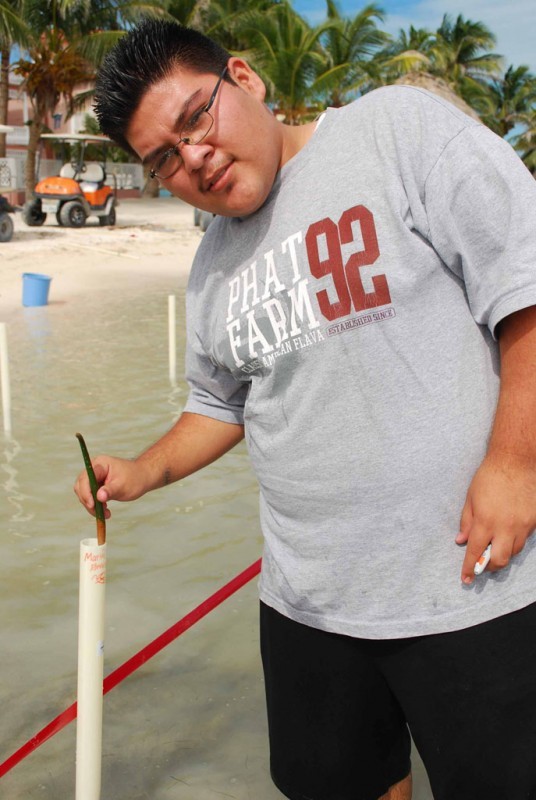
3. Planting a seedling properly ensures development.

4. Many concerned community members joined the campaign in the pilot REM site in northern San Pedro Town.

5. Mangrove sprouts. With proper monitoring mangroves have a better chance to survive.

6. Healthy Sprouts. In a matter of weeks, the results can be seen in the mangrove that grow with the protection of special pipes.
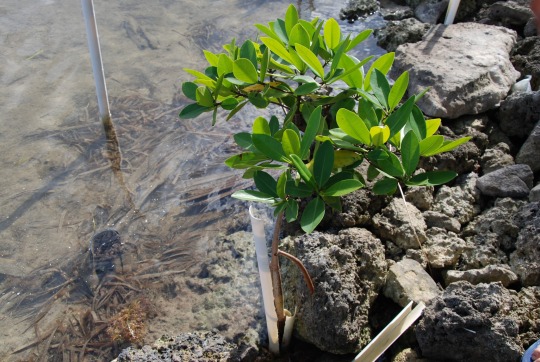
7. As the mangrove grows it breaks out of its protected shell (pipe).

8. With the supervision of environmentalists and volunteers the mangroves begin to grow.

9. In a period of three to five years, this coast of San Pedro Town will densely populated with mangroves, which will serve as nursing for different marine species and significantly reduced the coast erosion.

10. Mangrove seedlings were also planted beyond the shore in order help in sedimentation holding, enhancing the abundance of fishes.

11. This will be the end result after years of fostering and taking care of the mangroves.

12. Beneath these mangroves' roots lies a different world, full with life and future for the country.

13. Marine Biologist and advocate for the preservation of mangroves, Valentine Rosado, educates young students on the importance of taking care of our natural resources. In this case, he explains how mangrove help to prevent beach erosion.

14. An example of what erosion can do. If mangroves would have been present, probably this coconut tree would be on this beach for a much longer time.

15. Threats to mangroves. In recent years more development is happening on the coastal areas of Belize. In Ambergris Caye, this has become common in order to meet the demands of high-end tourism. As a result large areas of mangroves are cleared.

16. Many different marine life species depend on the mangrove. As it perishes, this affects not only the environment but other institutions like the fishing industry.

17. Mega tourism projects in the south and north of Ambergris Caye are slowly destroying hundreds of acres of mangroves.

18. It is almost impossible to stop development, since most of these areas are privately owned and permits are issued by the Department of Environment for mangrove clearance.

19. If such actions are not stopped, the future of the mangroves in Belize is in a fast decline, along with hundreds of marine species. Not to mention that our coastal areas will immensely devastated by heavy non-stop erosion.

20. A unique awareness campaign. This map shows key areas where the high concentrations of mangroves are located on the island of Ambergris Caye. Many of these areas have become vulnerable with the rapidly growth of the island.
The map also shows the path of an annual eco-challenge kayak race around the island in an effort to raise awareness among different organizations and race participants who have the privilege to compete along these majestic marine plants.

21. The race takes participants through channels completely surrounded by mangroves.

22. In certain areas the space widens, providing a broader appreciation of these important plants.

23. At the end of the day, competitors can better appreciate the monumental role of mangroves in our ecosystem and hopefully will join in the campaign to protect this plant species for the many future generations to come.
Valentine Rosado was very instrumental in the completion of this project. He provided me with valuable information on the mangroves and pointed out which areas on the island are vulnerable to human development. Additionally, he provided footages and insights on the re-forestation project taking place in Laughing Bird in Southern Belize. - Dion Vansen
ABOUT THE CLASS
#mangrove#reforestation#deforestation#belize#ambergriscaye#development#environment#erosion#coast#coastline#Riley Encased Methodology#REM
0 notes


